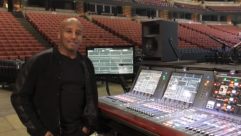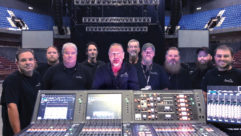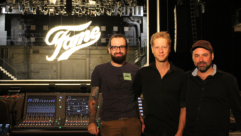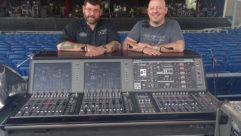
Yamaha M7CL
Apr 1, 2006 12:00 PM,
By John McJunkin
Simple and intuitive design that’s just right for digital live mixing.
The time for digital live mixers is here, and the options currently available are reminiscent of Goldilocks and the Three Bears. The Papa Bear digital console is big and sophisticated, but pricey. The Mama Bear digital console is inexpensive, but a little lacking in some key areas. The Yamaha M7CL is the Baby Bear digital live sound console — just right. There are super-sophisticated, super-expensive consoles, and there are inexpensive consoles that don’t quite have the goods, but now there’s a third way — a quality console at a reasonable price. Let’s pore through the details of Yamaha’s latest.
GETTING A FEEL FOR IT
Invariably, manufacturers of digital live consoles have attempted to make the operation of their consoles “as much like analog as possible” — a laudable goal to keep us old dogs comfortable with new tricks. But this is 2006. We are now comfortable with user interfaces that don’t have faders and knobs on every channel. Yamaha has capitalized on this notion by making the operation of the M7CL simple, yet effective, avoiding the chicanery of trying to make it “feel” one way or another. It’s just straightforward, with little attention to whether it feels digital or analog. I love this — it’s refreshing. The console I test drove had 48 faders, arranged in banks of eight, one above another, in three vertical arrays. In the central master section of the console, there are eight Centralogic faders, which can be used in multiple ways, for instance, as bus or group or DCA faders, among other things. To the right of these faders is a bank of navigation and selection pushbuttons. Above the faders is a nice 800×600 LCD touchscreen, a very important central node in the operation of this console. To the left of the touchscreen is a bank of rotary encoders. The combination of knobs, touchscreen, and a boatload of faders gives the M7CL a hybrid feel in terms of operation. I was able to quickly and easily navigate this console.
The touchscreen and the encoders to the console’s left control most of the unit’s operations. Among those are 16 Mix/Matrix knobs, which send levels to auxiliaries or the matrix. A single HA encoder determines head amp gain on input channels, and a pan pot determines panning for mono channels and left/right balance in the case of stereo channels. Since threshold is the most oft-grabbed knob in the dynamics section, there are two Dynamics knobs to control threshold for each of a channel’s two dynamics processors. An HPF encoder controls cutoff of a channel’s high-pass filter, and there are four iterations of encoders for fully parametric EQ (Q, frequency, and gain).
There are 12 user-defined keys below the touchscreen, one of which I used to tap tempo for a delay, along with a monitor level knob and Yamaha’s obligatory left/right/up/down keys for navigation, scene storage, and recall. There are also keys to determine what the Centralogic faders control. Each of the mixer’s channels has a fader, a six-segment LED meter, and keys for select, cue, and on. The Centralogic faders are the same, with the addition of a multi-function encoder knob. There are also similar channel strips for mono and stereo masters, although they lack metering — that’s handled on the main screen. Under the front pad are a headphone output and level control, and a balanced XLR talkback input and gain control.
CONNECTION AND OPERATION
The M7CL’s I/O is simple and elegant. There are 32 balanced XLR mono inputs, four stereo pairs of balanced XLR inputs, and 16 balanced XLR omni outputs. There is an AES/EBU output and a D-sub nine-pin remote connector for the control of a remote head amp unit, along with word clock and MIDI I/O pairs. Additionally, there’s an Ethernet jack for connection to a PC; three audio interface expansion slots to accommodate AES/EBU, ADAT, T-DIF, CobraNet, mLAN, or additional analog I/O; an AC power input and power switch; and a multi-pin DC power input. Finally, the 32-input version features a four-pin connector to power a gooseneck lamp, and the 48-input version features two four-pin connectors.
The I/O is simple, so connection was a snap. I jumped right in without needing to consult the manual, and I discovered that everything worked much as I expected. The user interface is marvelously elegant and intuitive. For example, you can select multiple objects on the screen at once with one swipe. I discovered this just by simply trying it.
The rotary encoders can be depressed, and in doing so, I got finer control of some parameters. There’s also a keyboard window enabling the entry of alphanumeric names of channels, snapshots, etc. I had occasion to view multiple channels simultaneously every now and again via the Overview screen, but more often than not, I found myself viewing the Selected Channel View screen. This view provides all the pertinent information about the currently selected channel, including mix/matrix sends, HA input gain level, panning, dynamics settings, HPF and EQ settings (including a graphic), insert, direct out, recall safe status, and finally a display of the DCA and mute groups in which the selected channel is included. Many of these displays provide pop-up menus with greater detail when they’re touched.
To the right of this entire section is another section that gives broader and more generic information, such as master meters, and it provides access to other operational areas such as the rack, where the M7CL’s signal processing exists. The rack offers four permanently available graphic EQs and four more rack spaces that can be filled with more EQs or any of 48 different effects. The four available rack spaces can be filled with graphic EQs, which are valuable as a monitor desk. One minor complaint: Four of the eight rack spaces are permanently devoted to EQ. It would be nice to allow the user to determine the use of all eight, but time-based DSP carries a heavy CPU load and Yamaha understandably wishes to limit the possibility of crashes or choking by limiting the number of available time-based processors. I was pleasantly surprised to discover that effects can also be inserted into channels as well.
Yamaha has a serious hit with this console. It is intended primarily for houses of worship, but it will be popular in numerous other applications. By avoiding the quagmire of trying to make the console “feel analog,” Yamaha has arrived at a simple and intuitive user interface that just works. This console has some sophisticated functionality, including bussing, DCAs, matrix routing, powerful scene recall and library functions, and general simplicity of operation.
Yamaha also has the M7CL Editor computer application, which enables operation of virtually every console parameter from a computer. I found myself drooling at the prospect of walking around with a WiFi notepad in a venue, tweaking EQ and other things. I guess I just have to come out and say it … I love this console. I brought in a number of trusted colleagues to play with it, and we reached 100 percent consensus, with many exclamations of “Wow!” and “This thing is great!” The M7CL sports significantly more power than its price would portend, and it is worth consideration.
PRODUCT SUMMARY
Company: Yamaha Corporation of America www.yamahacommercialaudio.com
Product: M7CL
Pros: Very high feature-to-price ratio.
Cons: Effects “rack” lacks some flexibility.
Applications: Intended for houses of worship, but works well for other apps.
Price: M7CL-48: $24,999; M7CL-32: $19,999
SPECIFICATIONS
Sampling Frequency: Internal: 44.1kHz, 48kHz, External: 44.1kHz (-10%) to 48kHz (+6%)
Signal Delay: Less than 2.5 ms input to omni out (@Fs = 48kHz)
Fader: 100mm motorized x62 (46)
Fader Resolution: +10 to -138, -dB (1024 steps/100mm)
Maximum Voltage Gain: 86dB input 1-48 to omni out
Crosstalk: (@1kHz) -80dB Adjacent Input Channels (input 1-48, st in 1-4 [L, R], (gain:min) to omni out 1-16)
Dimensions: (W×H×D) M7CL-48: 1274×286×701mm M7CL-32: 1060×286×701mm
Net Weight: M7CL-48: 50kgM7CL-32: 42kg
Power Requirements: M7CL-48: 300W, 110-240V 50/60Hz M7CL-32: 250W, 110-240V 50/60Hz
John McJunkinis the principal of Avalon Audio Services in Phoenix, and consults in both studio commission and live sound applications. He is also a key figure at the renowned Conservatory of Recording Arts & Sciences.










